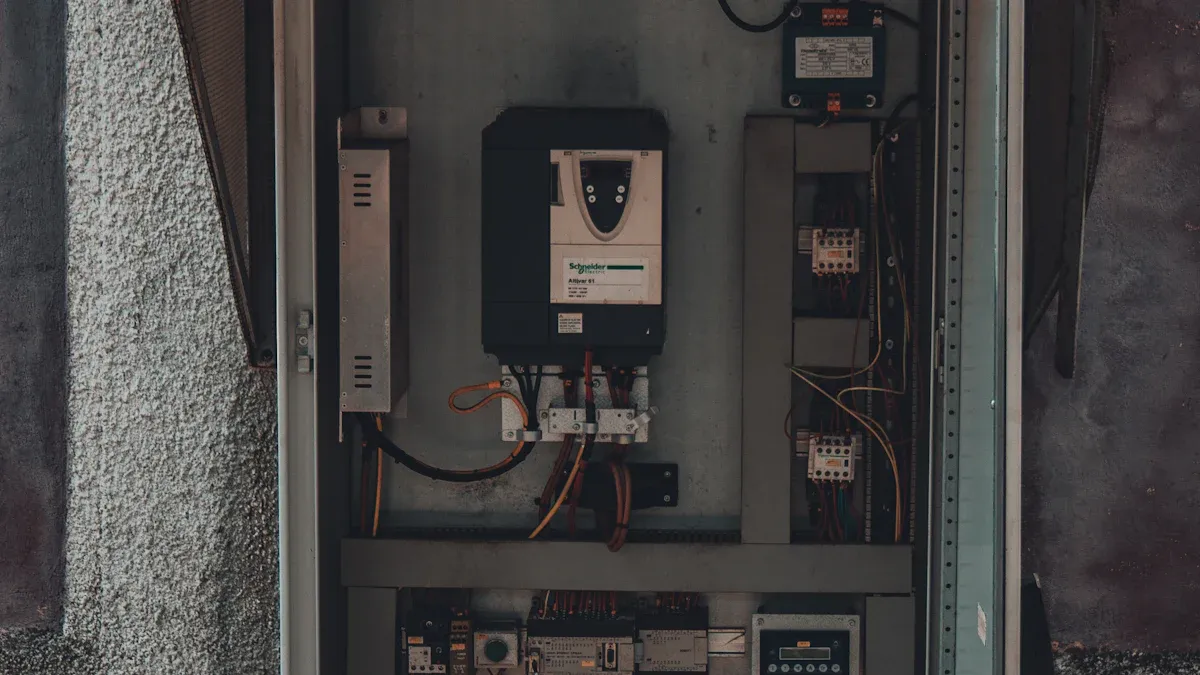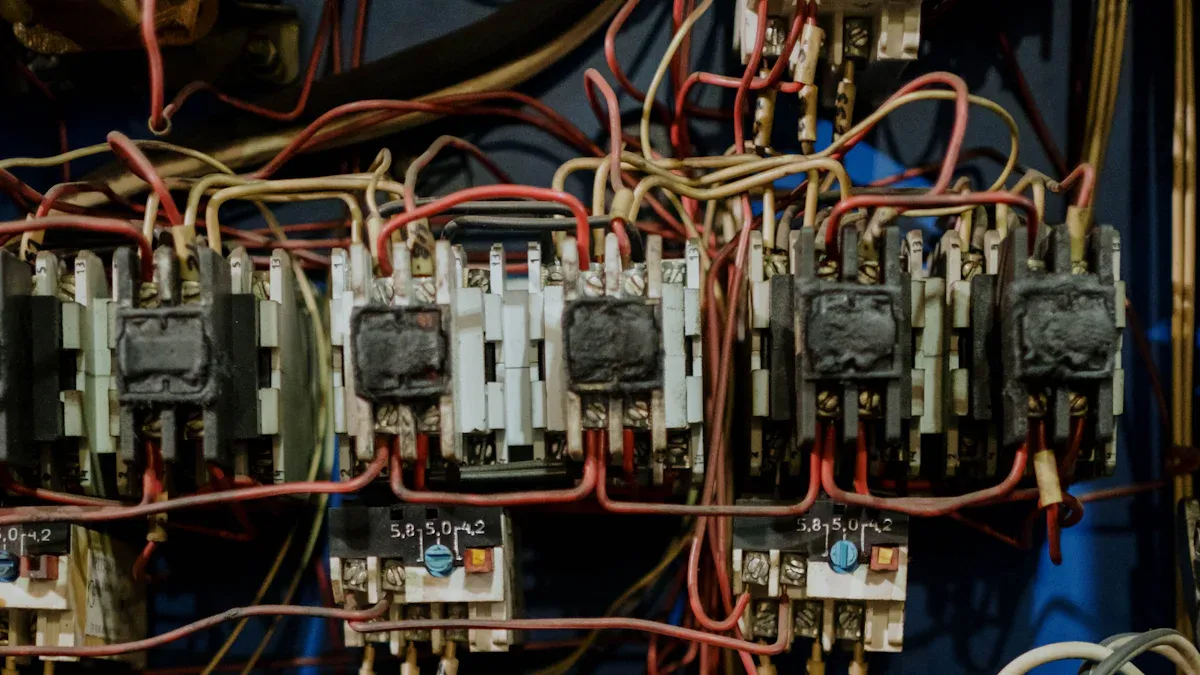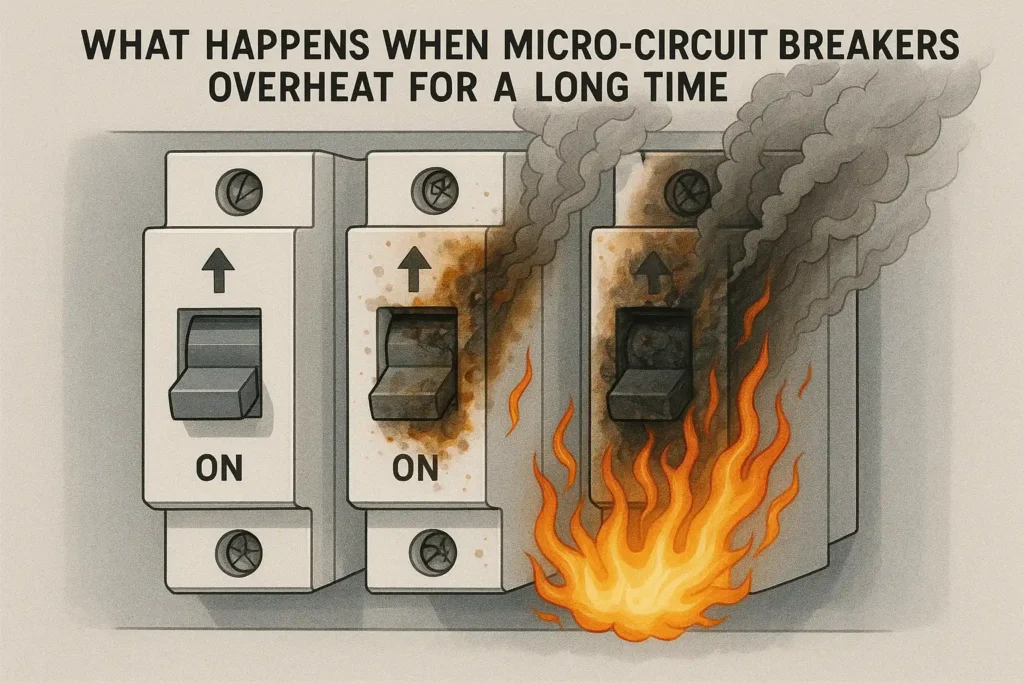Micro-circuit breaker overheating can be very dangerous. If heat stays for a long time, the device might stop working right. It may not protect electrical circuits anymore. Wires can melt or make sparks. People might smell something burning or see smoke. If you ignore this, fire or damage can happen. Safety goes down when micro-circuit breakers do not work as they should.
Key Takeaways
- Micro-circuit breakers can get too hot from too much power. Loose wires, old parts, or hot and dusty places can also cause this.
- Signs of overheating are heat, burning smells, and black marks. Breakers may trip a lot for no clear reason.
- If breakers get too hot, they can stop working fast. Wires can get damaged. The chance of fires and electric shocks goes up.
- Checking breakers often helps keep them safe. Tighten connections and control power use. Replace old breakers on time.
- Smart breakers and good care help find problems early. They protect people and buildings from electrical dangers.
Causes of Micro-circuit Breaker Overheating
Overloading
Overloading happens when too many things use power from one circuit. The micro-circuit breaker has to handle more current than it should. This extra current makes the breaker get hot inside. If this keeps happening, the breaker can become very hot. Overloading is a main reason for micro-circuit breaker overheating. It can make the breaker trip or stop working. When this happens, there is a bigger chance of fire or damage.
Loose Connections
Loose connections in the breaker or at the ends can cause problems. If wires are not tight, electricity does not move well. The loose spots make resistance, which turns into heat. Over time, this heat can hurt the breaker. Loose connections often cause micro-circuit breaker overheating. People might see lights flicker or smell something burning when this happens.
Aging Parts
Old parts in a micro-circuit breaker can make it overheat. Many old buildings and data centers use breakers that are very old. These breakers may not be as safe as new ones. They often cannot handle today’s bigger power needs. As parts get older, the chance of overheating and fire goes up. Experts say replacing old breakers makes things safer. New breakers use better technology to stop overheating.
Environmental Factors
Things around the breaker can also make it overheat. High room temperatures can make breakers hotter than normal. Humidity and water can cause rust inside the breaker. Dust can pile up and block air, trapping heat. These things make it easier for the breaker to get too hot and break. In places with lots of heat or water, breakers may not last as long. Cleaning and keeping the room cool can help lower these risks.
Warning Signs

Heat and Smell
Heat is one of the first warning signs of micro-circuit breaker overheating. When a breaker feels hot to the touch, it signals a problem. Research by Aronstein (IEEE Access, 2019) shows that higher temperatures can change how a breaker works. The study found that as temperature rises, the breaker may trip at lower currents. This means the breaker might not protect circuits as it should. People may also notice a burning odor. The smell often resembles overheated electronics or melting plastic. This odor comes from insulation or plastic parts getting too hot. A strong smell means the breaker needs attention right away.
Tip: If someone smells burning near the breaker panel, they should check for heat or call a professional.
Scorch Marks
Scorch marks are another clear sign of trouble. These marks appear as dark or discolored spots around the breaker or on the panel. They show that heat has damaged the surface. Sometimes, people see small burns or melted plastic. These marks mean the breaker has been hot for a while. Visual inspection can help spot these problems early. Thermography, or thermal imaging, can also find hot spots before scorch marks appear. If scorch marks are present, the breaker may already have internal damage.
- Scorch marks often point to loose connections or overloads.
- Melted or burned areas mean the breaker needs replacement.
Nuisance Tripping
Nuisance tripping happens when a breaker trips often without a clear reason. This can be a sign of micro-circuit breaker overheating. Frequent tripping may mean the breaker is too hot or has a weak part inside. The breaker might trip even when the load is normal. Dimming or flickering lights can also happen during these trips. Over time, nuisance tripping can lead to bigger problems. It can signal that the breaker is no longer safe to use.
Note: If a breaker trips often, it should be checked for heat, loose connections, or aging parts.
Effects of Overheating

Short-term Effects
When micro-circuit breakers get too hot, problems show up fast. The breaker might trip more than it should. This can turn off lights, computers, or machines. People might see lights blink or devices turn off suddenly. The breaker can feel very warm if you touch it. Sometimes, a burning smell fills the air. These signs mean the breaker cannot handle the heat.
- Devices might stop working without warning.
- Lights may blink or get dim.
- The breaker could make clicking noises.
⚠️ Alert: If a breaker feels hot or trips a lot, it needs help right away.
Long-term Damage
If micro-circuit breakers overheat for a long time, they get badly damaged. The plastic inside can melt and lose strength. Metal parts might bend or change shape. The breaker might stop working even if the power is normal. Wires that connect to the breaker can also get hurt. The covering on the wires can burn or crack. This kind of damage does not fix itself.
| Long-term Damage | What Happens |
|---|---|
| Melted plastic | Breaker gets weak |
| Warped metal | Breaker cannot trip right |
| Burned wire insulation | Wires are not safe |
| Broken internal parts | Breaker cannot protect circuits |
Old or broken breakers cannot stop overloads or short circuits. This makes the whole system less safe.
Safety Risks
Micro-circuit breaker overheating makes things more dangerous for people and buildings. The chance of fire goes up when breakers get too hot. Burned wires or melted parts can start a fire in the panel. People might get shocked if they touch a broken breaker. Studies show that high heat is a clear sign of trouble in circuit breakers. Experts use special tools and smart computers to check for high heat. These tools help find problems early and show when a breaker might fail. When the risk of failure goes up, fixing the breaker becomes very important.
🔥 Note: Fires from electrical panels can spread fast and cause big damage.
Micro-circuit breaker overheating can also cause power to go out. Hospitals, schools, and businesses might lose power if breakers fail. This can stop important machines from working. Keeping breakers cool and in good shape helps stop these problems.
Prevention and Maintenance
Regular Inspection
Checking micro-circuit breakers often helps stop overheating. Technicians look for damage, dirt, or cracks. They use thermal cameras to find hot spots. These checks catch problems before they get worse.
- Cleaning off dust keeps breakers from getting too hot.
- Looking for cracks or burns shows if repairs are needed.
- Thermal cameras help find hot spots early.
- Resistance tests show if any connections are loose.
Tip: Checking breakers often keeps electrical systems safe and working well.
Tightening Connections
Loose connections make heat and can cause trouble. Technicians use special tools to tighten each connection. They follow the maker’s rules for how tight to make them. Using a torque wrench helps make sure bolts are tight enough.
- Tight connections stop hot spots from happening.
- The right tightness lowers the chance of overheating.
- Resistance tests help find weak connections.
Note: Tightening connections during checkups stops many problems.
Load Management
Load management means spreading out devices so no breaker works too hard. Technicians balance the load on all circuits. They move big devices to other breakers if needed. This keeps each breaker safe.
- Balanced loads stop overheating and tripping.
- Breakers with too much load break faster and can fail.
⚡ Good load management keeps everything working well.
Replacement
Sometimes, breakers get too old or damaged to be safe. Replacing them on time stops failures. New breakers work better and last longer. Maintenance teams know when to change old breakers. They also help put in smart breakers that watch themselves.
| Smart Feature | Benefit |
|---|---|
| Overcurrent Preemption | Stops failures and helps breakers last longer |
| Computer Algorithms | Uses energy better and saves money |
| Anomaly Detection | Finds problems early and makes things safer |
Paying for good maintenance and new breakers saves money and keeps people safe. Smart breakers need experts to work best.
If you ignore signs that micro-circuit breakers are too hot, bad things can happen. Fires might start, equipment can break, and people could get hurt. Doing regular checkups and fixing problems fast helps stop these dangers.
- Testing and cleaning often make equipment last longer and keep people safe.
- Skilled workers use special cameras and tests to spot trouble early.
- Checking on a schedule and writing reports helps systems work well and stops long breaks.
If problems keep happening, calling a trained electrician is the best way to keep everyone and everything safe.
FAQ
What causes a micro-circuit breaker to overheat?
A micro-circuit breaker gets too hot for a few reasons. Too much current can make it overheat. Loose connections inside the breaker also cause heat. Old parts inside can add to the problem. Hot rooms, dust, or water make overheating more likely. All these things raise the temperature inside the breaker.
What should someone do if a breaker feels hot?
If a breaker feels hot, turn off the power right away. Do not touch the breaker with your hands. Call an electrician who has a license. Heat means there is a problem that needs fast help.
What are the dangers of ignoring overheating signs?
If you ignore signs of overheating, bad things can happen. Wires might melt and equipment can break. Sometimes, a fire can start. The chance of getting shocked goes up too. It is less safe when people do not fix these problems.
What does nuisance tripping mean?
Nuisance tripping is when the breaker shuts off power a lot. There is no clear reason for this to happen. This often means the breaker is too hot or has a weak part. It is a sign that someone should check the breaker.
What maintenance helps prevent overheating?
Doing regular checks helps stop overheating. Tightening all the connections is important. Making sure the power is spread out keeps things safe. Replacing old or broken breakers also helps.
Tip: Doing maintenance on a schedule lowers the chance of failure or fire.
The following information may be of interest to you
What Causes a Circuit Breaker to Trip Without Restoring Electricity
What Causes Circuit Breaker Overheating and How to Prevent It
Is it Safe to Plug One Surge Protector into Another?
Why a bad circuit breaker can cause low voltage



